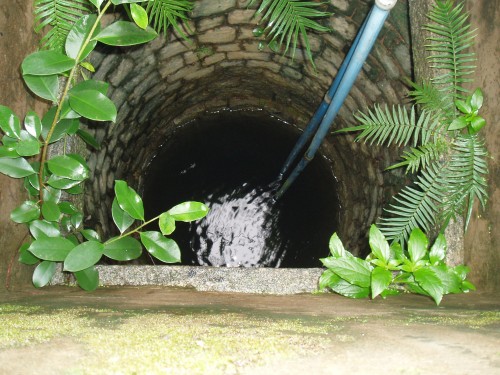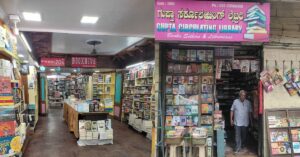TBI Water Heroes: Chandra Shekar – Presenting A Strong Case For Open Wells
The monsoons are here! As many parts of India are celebrating the relief from scorching summers, let us not forget that this year India faced one of its worst water

The monsoons are here! As many parts of India are celebrating the relief from scorching summers, let us not forget that this year India faced one of its worst water crises, and what is even more disheartening, the predictions for availability of potable and usable water are bleaker for the coming years. This report co-authored by McKinsey & Company predicts that India needs to double its water-generating capacity by 2030 to meet the demands of its burgeoning population. Another independent study shows that groundwater in major Indian cities like Delhi, Mumbai, Chennai and Hyderabad is declining so rapidly that they might soon be bone dry! Even with the onset of rains, water scarcity is a problem that remains. So is there no hope?
Fortunately, there is. This week, we pay tribute to Water Heroes: People and Organizations who have been at the forefront of water conservation and reuse – by restoring and reviving water bodies, recharging groundwater or optimizing the use of water resources. We bring to you their ideas and methodologies so that we can all appreciate their work, support it and implement it in our own surroundings!
In the first article of the series, we present Mr. S Chandra Shekar, who lays down the case for open wells, and shares his own experience of creating one in his home at a locality called Jayanagar in Bangalore. He explains in detail the process of water supply and distribution, taking the case of Bangalore in particular, but it applies to every city in India and is a good guide to understand how these systems work (or not work!), and how we can move to a more sustainable living in terms of our water needs.
A Brief History:
Years ago, there was no system of underground sump, overhead tank and piping for water supply. The only source of water to houses and institutions was the open well in the garden or backyard. First of all there were houses and cottages built on land – not apartment blocks. There was enough setback in all the directions and there was enough space for a garden and a well. The rains fed the open wells through percolation pits located near the wells and water filled up the pits, moved through the ground, got filtered and fed the wells’ cavities. There was always enough water , even in shallow wells, to supply a family’s needs comfortably. The water was not pumped out, but drawn out by using ropes and pulleys.
As late as the 1950s and even the 1960s in most towns, villages and cities, the open well was present and vital as a means of supplying water.
Then came the centrifugal pump and suction and delivery piping. The water was pumped from the well to the overhead tank and then distributed all over the house through pipes. Later on, piped water came from the centralised Water Board and BWSSB (Bangalore Water Supply and Sewerage Board). This water was supplied to wards and layouts by means of underground pipes, and fed the underground sumps which stored the water. This water was pumped directly from the sump to the overhead tank and distributed all over the house.
This was when the open well was abandoned and forgotten. A big folly!
The Water Board and BWSSB get their water from the big dams near Mysore and pump it uphill to Bangalore, so that they can feed the sumps in the individual houses. Now, when the Krishnarajasagar and other dams are empty because of failure of the rains, there is no water to feed the sumps.

This photo of Krishnarajasagar Dam is courtesy of TripAdvisor
If only the people had not abandoned the open wells and started depending blindly on the piped water, there would have been a back up system in place if the rains failed. But the open wells have all or almost all gone and disappeared now.
Besides the open wells, in the olden days, we had a simple treatment plant in the garden to clean and purify the waste water from the kitchen, bathrooms, showers and handwash sinks. This water, called Grey water, was initially sedimented by adding alum and other coagulants and allowed to settle. The overflow was taken and run over a small slope of rocks and pebbles to allow aeration and oxygenation of the water. The collected water was again allowed to settle and the overflow was passed through a filter made out of intermediate layers of sand, pebbles and charcoal to clarify the water. The final collected water was again allowed to settle and the overflow stored in a tank. This water as used for gardening, cleaning vehicles, washing floors, etc, other than drinking and bathing. The toilet flush water was passed into a septic tank and soak pit. The septic tank was an anaerobic chamber where biological degradation of sewage took place and the collected sediment became good quality compost. The overflow water went to the soak pit which percolated to the ground, got filtered naturally in the soil and joined the underground aquifers.
This was the way sustainable housing was operated in the 1960s . Our total dependence on the Government bodies for both fresh water supply and sewage treatment has removed initiative from us and we have become dependent on systems which fail often.
Why can’t we be independent and self reliant?
A lot of rain falls on the roads and flat surfaces. When Jayanagar was first formed we had percolation pits at strategic places on the sides of the roads which collected rainwater and fed them or rather pushed them into the soil by means of gravity. Rather than have choked up storm water drains, several percolation pits will trap the rainwater where it falls and feed it into the ground for recharging the aquifers.
I have seen old buildings in Mysore where the rainwater from the roof is collected, passed on through pipes to the basement collection tank. In the basement there is a big waterproof tank to store rainwater. The overflow water from this basement tank feeds into a channel leading outside the house into the garden and feeds a pond or a small lake. During the rainy season, there is so much water, that the overflow water leads to overflowing of the pond. In some places where the house is in a village, the pond is located in a ground where cattle and sheep can drink water and villagers can bathe and wash clothes.
Modernisation with piped water and centralised water systems for supply has robbed us of our creative genius and innovation. I think we should go back to basics and fundamentals and apply simple solutions to overcome the present water crisis, instead of asking the Government to do something.
Water Shortages – An Open Well RWH solution:
Bangalore is well known for its open wells. So why don’t we revive and take care of our open wells? Places like Malleswaram, Basavanagudi, Jayanagar and VV puram have large wells in the gardens of houses.
I have a house in Jayanagar which is 50 years old, and has a well which is 35 feet deep and about 3 feet in diameter. Many years ago – around 15 years ago – I installed rooftop Rain water harvesting structures. I collect around 1 Lakh Litres (100,000 Litres) of rainwater each year. I filter the collected water from the roof and feed it to the well. In about two weeks of rainfall, the well is full of filtered water. The photos below show the well brimming with water. These photos were taken last season.
I have estimated that I consume around 40,000 litres of water each year from the well. The remaining 60,000 litres feed the ground water aquifers. This is a substantial amount of water both for home consumption as well as ground water recharging. During the rainy season I am happy to shut off the BWSSB supply valve. When I use well water for all our needs, I not only save on my BWSSB bills but also precious Cauvery river water which is now available for other users.
The rain water harvesting solution is simple and one can do it oneself. It is a self-help aid. The cost involved is only for the PVC pipes and filter. In my case I did the plumbing work myself, and it did not cost me much.
I wish other citizens of our country help themselves and become self-reliant as regards water needs.
Feel free to contact Chandra Shekar for any queries or assistance in setting up water structures in your own home or community. He can be reached at [email protected] or +91 80 26631329.
This story made me
- 97
- 121
- 89
- 167
Tell Us More
We bring stories straight from the heart of India, to inspire millions and create a wave of impact. Our positive movement is growing bigger everyday, and we would love for you to join it.
Please contribute whatever you can, every little penny helps our team in bringing you more stories that support dreams and spread hope.



















